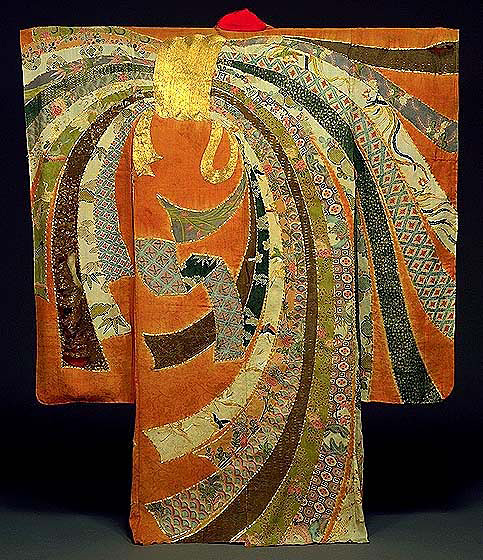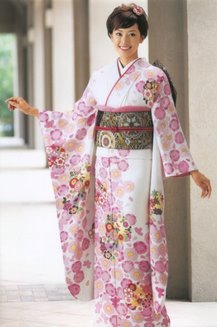Difference between revisions of "Furisode"
Weird Bird (talk | contribs) m (→Links: Fixed a dead link, removed a link to a product no longer being sold, and removed a link to a Wikipedia article.) |
|||
| (3 intermediate revisions by 2 users not shown) | |||
| Line 1: | Line 1: | ||
| + | {{Cleanup | ||
| + | |reason=information copied directly from external site | ||
| + | |date=April 2016 | ||
| + | }} | ||
| + | |||
[[Image:Item07bfurisode.jpg|thumb|Mid Edo period Furisode]] | [[Image:Item07bfurisode.jpg|thumb|Mid Edo period Furisode]] | ||
| − | The furisode is a long sleeved kimono | + | The furisode is a long sleeved [[kimono]] worn by unmarried women. The name furisode literally means "swinging sleeves". The sleeves are normally 39-42 inches. The furisode is made of very fine, brightly colored silk with elaborate decorations and brocade, and is commonly rented or bought by parents for their daughters to wear when celebrating Coming of Age Day the year they turn 20. By wearing a furisode, a young woman signifies that she is both single and a legal adult, and thus available for marriage. This is the most formal kimono for unmarried women. It is also worn weddings of close relatives. As a furisode can be very expensive, many women rent them as needed rather than purchasing them. A furisode normally costs about ¥100,000 to ¥300,000 to rent and over ¥1,000,000 (approximately $10,000 US) to purchase. |
| − | |||
| − | |||
| − | The obi is usually not tied in the taiko musubi (taiko drum bow) but more elaborate bows tied with fukuro or even maru obi is used. The most popular bow is the tateya musubi (standing arrow), the fukura suzume (plump sparrow) or the bunko musubi with hanging ends. | + | Classified into three types by the length of its sleeves, they are called as "Oh- Furisode" (long furisode, 105 cm), "Chu-Furisode"(middle furisode, 90 cm) and "Ko-Furisode" (small furisode, 75 cm). The status is based on "the longer the higher" basis. Some decades ago, brides wore black-based Oh-Furisode as their wedding dresses, yet they wear colored Oh-Furisode in today's wedding ceremony. Furisode is usually made of those valued materials such as Rinzu (damasked glossy silk material) or Chirimen (crepe) material and designed in "Eba" composition which is the patterns spread over panels as if it were a big painting when displayed. Sumptuous patterns, especially, are drawn elegantly by Yuzen technique, and thus, the magnificence of Furisode is accomplished by all kinds of elaborate [[Japanese]] traditional art crafts. |
| + | [[Image:Furisode-custom.jpeg|left|thumb]] | ||
| + | The [[obi]] is usually not tied in the taiko musubi (taiko drum bow) but more elaborate bows tied with fukuro or even maru obi is used. The most popular bow is the tateya musubi (standing arrow), the fukura suzume (plump sparrow) or the bunko musubi with hanging ends. | ||
| − | The accessories are colorful and is selected to accentuate the young and beautiful appearance. The way the obi age is worn often differs from other occasions - instead of tied in a knot and tucked into the gap between the obi and kimono, it is overlaying this gap and folded into the panels of the kimono. The furisode is almost always worn with a date eri (a detachable collar as the red line at the collar, above)matching the obi or accessories. It gives the impression that the kimono consists of several layers, although the extra fake layer rarely appears at the sleeve openings or hem of the kimono. | + | The accessories are colorful and is selected to accentuate the young and beautiful appearance. The way the obi age is worn often differs from other occasions - instead of tied in a knot and tucked into the gap between the obi and kimono, it is overlaying this gap and folded into the panels of the kimono. The furisode is almost always worn with a '''date eri''' (a detachable collar as the red line at the collar, above)matching the obi or accessories. It gives the impression that the kimono consists of several layers, although the extra fake layer rarely appears at the sleeve openings or hem of the kimono. |
===Links=== | ===Links=== | ||
| − | *[ | + | *[https://web.archive.org/web/20090412023930/http://lovekimono.googlepages.com:80/furisode blog] |
| − | |||
| − | |||
| − | [[Category:Japanese Garb]] [[Category:Garb]] [[Category:How To]] | + | [[Category:Japanese Garb]] [[Category:Garb]] [[Category:How To]][[Category:Women's Garb]] [[Category:Dress]] |
Latest revision as of 08:53, 10 February 2024
| This article may require cleanup. The specific problem is: information copied directly from external site. Relevant discussion may be found on the talk page. Please help improve this article if you can. (April 2016) |
The furisode is a long sleeved kimono worn by unmarried women. The name furisode literally means "swinging sleeves". The sleeves are normally 39-42 inches. The furisode is made of very fine, brightly colored silk with elaborate decorations and brocade, and is commonly rented or bought by parents for their daughters to wear when celebrating Coming of Age Day the year they turn 20. By wearing a furisode, a young woman signifies that she is both single and a legal adult, and thus available for marriage. This is the most formal kimono for unmarried women. It is also worn weddings of close relatives. As a furisode can be very expensive, many women rent them as needed rather than purchasing them. A furisode normally costs about ¥100,000 to ¥300,000 to rent and over ¥1,000,000 (approximately $10,000 US) to purchase.
Classified into three types by the length of its sleeves, they are called as "Oh- Furisode" (long furisode, 105 cm), "Chu-Furisode"(middle furisode, 90 cm) and "Ko-Furisode" (small furisode, 75 cm). The status is based on "the longer the higher" basis. Some decades ago, brides wore black-based Oh-Furisode as their wedding dresses, yet they wear colored Oh-Furisode in today's wedding ceremony. Furisode is usually made of those valued materials such as Rinzu (damasked glossy silk material) or Chirimen (crepe) material and designed in "Eba" composition which is the patterns spread over panels as if it were a big painting when displayed. Sumptuous patterns, especially, are drawn elegantly by Yuzen technique, and thus, the magnificence of Furisode is accomplished by all kinds of elaborate Japanese traditional art crafts.
The obi is usually not tied in the taiko musubi (taiko drum bow) but more elaborate bows tied with fukuro or even maru obi is used. The most popular bow is the tateya musubi (standing arrow), the fukura suzume (plump sparrow) or the bunko musubi with hanging ends.
The accessories are colorful and is selected to accentuate the young and beautiful appearance. The way the obi age is worn often differs from other occasions - instead of tied in a knot and tucked into the gap between the obi and kimono, it is overlaying this gap and folded into the panels of the kimono. The furisode is almost always worn with a date eri (a detachable collar as the red line at the collar, above)matching the obi or accessories. It gives the impression that the kimono consists of several layers, although the extra fake layer rarely appears at the sleeve openings or hem of the kimono.

